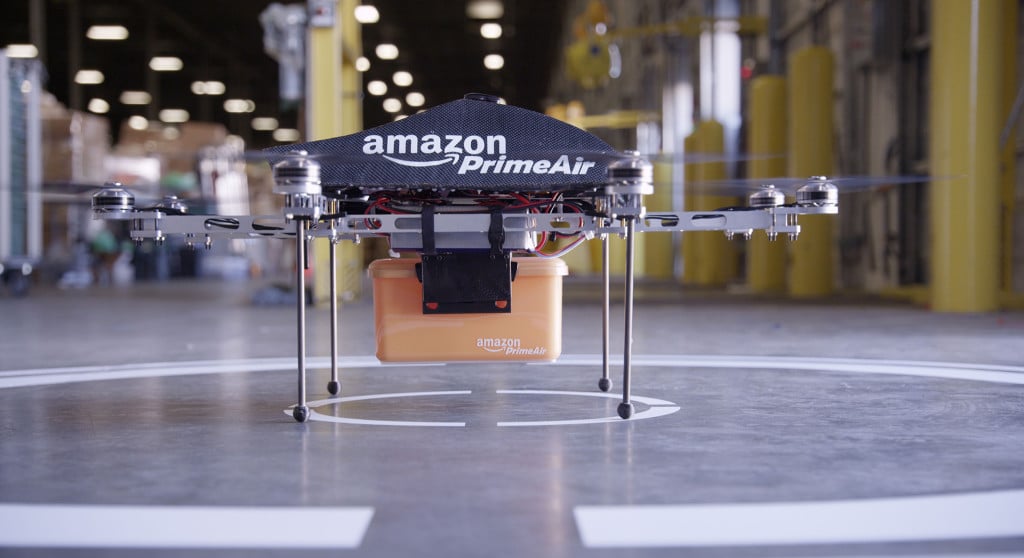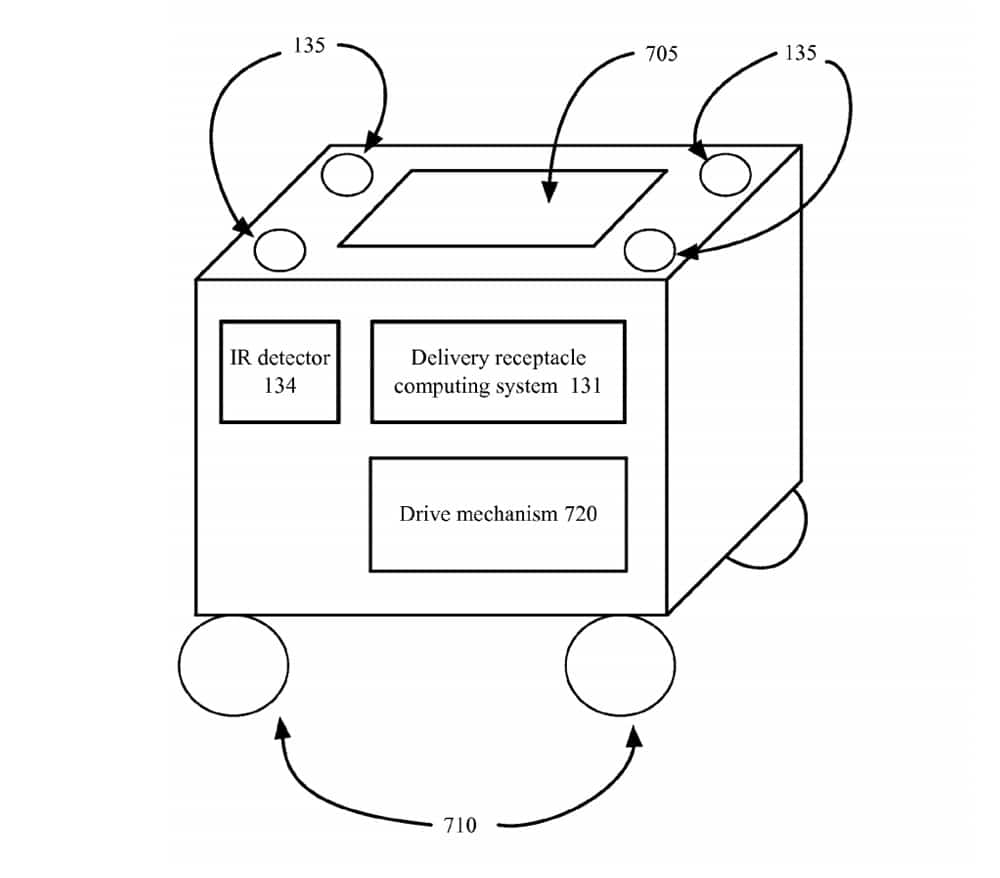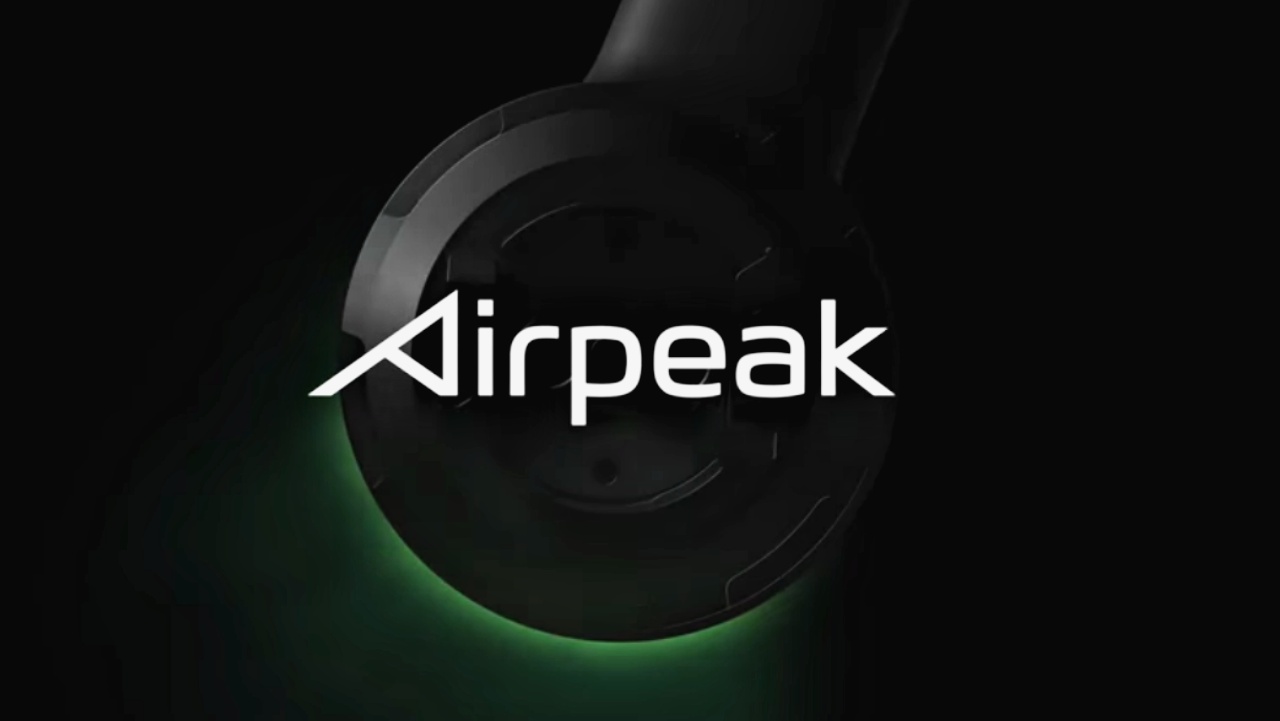Drones
Drone Delivery Wars

Remember Prime Air? Amazon’s grand plan to deliver packages via drones with a promise of deliveries in 30 minutes or less. The vision was unveiled by Amazon CEO Jeff Bezos with much fanfare way back in December 2013, but has since remained one of those big ideas that has failed to lift off, literally.
More than two years later, Amazon Prime Air is still stuck in legal limbo with regulators in a bind over safety concerns. Until specific regulations for commercial use of “small unmanned aircrafts” are finalized, commercial drones cannot take to the sky.
But for Amazon Prime Air to become a reality, there are other challenges that need to be addressed. One specific shortcoming is a problem that rival Google seems to have found an answer to.

Amazon Prime Air Drone with package in an Amazon warehouse facility just before takeoff for delivery.
Amazon’s concept requires that you are at your delivery address at the time the drone is about to drop of your package. Meaning, forget about a change in schedule or friends inviting you out for drinks last minute. Unless you want to risk someone else walking away with your package, you’ll have to stick around until the Amazon drone shows up with your order.
Google recognized this and has come up with an idea that would allow you to order goods online and have it delivered to your doorsteps even without anyone being home. Just days ago, the US Patent Office granted Google a patent that provides us with a unique insight into how Google is planning to win the drone delivery war.

Drawing of a mobile delivery receptacle as submitted by Google to the U.S. Patent Office.
So how is Google planning to solve the Amazon Prime Air dilemma?
The answer is simple and brilliant at the same time.
The basic idea involves a “mobile delivery receptacle” developed to work in tandem with delivery drones.
Details on the receptacle are still somewhat murky. The image filed with the patent shows a box on wheels. But to spark your imagination, just think of the delivery receptacle as an R2D2-like droid from Star Wars.

You keep the droid at home. After the droid is notified of a pending delivery, it would move outside to communicate with the drone in mid air. Infrared beacons would then be used to guide the droid to a precise meeting point for the drone delivery. After the package is received, the droid would then transport the package to a secure location, such as your garage. Safe and sound while you are out enjoying the evening with friends.
Project Wing
Both inventions are part of an initiative codenamed Project Wing, the latest project to come out of X, Alphabet, Inc.’s top secret research and development facility.
Alphabet is Google’s parent company and X is essentially a high-tech lab setup to develop and test all their new cool and groundbreaking technology gadgets.
Other top secret X projects that have come out of the shadows include, “Glass” for augmented reality, “Loon” for Internet-by-air-balloons, and “Driverless Cars”.
Like Amazon, Google is keen on getting a head start in the drone delivery business. It has ambitious plans of getting from concept to reality by 2017.
The company has been working on Project Wing for two years already, its existence confirmed by no less than Google Cofounder Sergey Brin in August 2014. Brin also confirmed a drone-testing facility in the Australian Outback with a hybrid drone that can take off vertically (like a rocket) and then rotate mid air to a horizontal position to fly around.
Why Australia, you may ask. The answer is simple. The Outback is a big empty place, except for some kangaroos and the occasional tourist. This allows the Australian government to be way more relaxed around unmanned aircrafts in its airspace.
[irp posts=”10750″ name=”Drone assists in 2017 NBA All-Star Dunk Contest”]


The ever-competitive drone market will soon have another brand to welcome. Sony just announced its entry into the consumer drone market with the Airpeak brand, which will likely go toe-to-toe (propeller to propeller?) with established brands like DJI.
Specific details about the brand, however, remain scarce at the moment. Sony’s official website only teases a short cryptic video.
The website also mentions that Airpeak will be the culmination of “imaging and sensing technological expertise and AI Robotics” — something which Sony has with its consumer camera and robotic products.
A separate press release also confirms Sony’s plan to target video creators with the Airpeak brand. Further, the brand will bring 3R technology (Reality, Real-time and Remote) to the drone market.
The first wave of products under the Airpeak is slated to launch in the spring of 2021. In the meantime, Sony will continue to obtain feedback from users who participated in co-creating drones under the brand.
It is worth noting that this isn’t Sony’s first foray into the drone market. Last year, the company entered a partnership with ZMP to form the Aerosense company. However, that company caters specifically to the business sector. So, the Airpeak brand will actually be the company’s first for the consumer drone sector.
Drones
How the tech world helped in the Notre Dame fire incident
Modern technology isn’t our foe at all

In light of the recent news about the fire incident that happened in the Notre Dame Cathedral in Paris, France, several companies, including those from the tech sector, have shown how much they care for the ruined 856-year-old historic landmark.
DJI
When the flames broke out, firefighters used Mavic Pro and Matrice M210 drones. The cathedral was severely damaged but thankfully, the drones helped in distinguishing where the fire had spread out. Several tweets show how helpful drones are, even during unexpected disasters like this one.
— Alexandre Fremont (@alex_fremont) April 15, 2019
People from DJI talked about how their drones helped Paris’ Emergency Response Team in determining the fire inside the cathedral.
Learning that Emergency Response for Notre Dame also included the use of drones, made me feel good. Then seeing a female operator made me proud. Both individually are not common, both together even less. Such a difficult incident to deal with, done with exemplary. pic.twitter.com/Qdh3UIwmer
— Romeo Durscher (@romeoch) April 16, 2019
Craftsmen built Notre Dame eight centuries ago. Now it may be up to robots to save it.https://t.co/zyfMU1lEuI
— Brendan Schulman (@dronelaws) April 17, 2019
Apple
After the incident, many people, including popular icons all around the globe, have shown their distress about the destruction of the cathedral. Tim Cook, the CEO of Apple, is one among those people. He even promised Apple would help in the progress of rebuilding Notre Dame’s ruined architectural landscape.
We are heartbroken for the French people and those around the world for whom Notre Dame is a symbol of hope. Relieved that everyone is safe. Apple will be donating to the rebuilding efforts to help restore Notre Dame’s precious heritage for future generations.🇫🇷
— Tim Cook (@tim_cook) April 16, 2019
Ubisoft
Most gamers can tell that the Notre Dame Cathedral is found in the gameplay of Assassin’s Creed: Unity. Ubisoft, which is also a French company, said that the infrastructure was scanned using their state-of-the-art 3D mapping technology. Using data preserved for the game may help architects and builders in restoring the cathedral. As an addition, the game is for free at the Ubisoft store to honor the fallen landmark.
It may be insignificant for most people but these all prove that companies and their existing technologies can still help in times of global incidents like this.

We won’t bore you with a rundown of its specs, but instead, we’ll give you the lowdown on DJI’s new drone — what works, what doesn’t, and what’s there to love. This is our DJI Mavic 2 Pro review.
-

 Accessories2 weeks ago
Accessories2 weeks agoApple Vision Pro Review: Two Months Later
-

 Features4 days ago
Features4 days agoFortify your home office or business setup with these devices
-

 Gaming1 week ago
Gaming1 week agoThe Rogue Prince of Persia looks like an ultra-colorful roguelite
-

 Philippines2 weeks ago
Philippines2 weeks agovivo Y100 to release in Philippines on April 27
-

 Gaming1 week ago
Gaming1 week agoStar Wars Outlaws release date revealed
-

 Events1 week ago
Events1 week agoStellar Blade: PlayStation taps cosplayers to play Eve for game’s launch
-

 Deals2 weeks ago
Deals2 weeks agoSamsung Awesome April: Deals on Galaxy A series
-

 Accessories1 week ago
Accessories1 week agoLogitech unveils G Pro X 60 gaming keyboard: Price, details




















